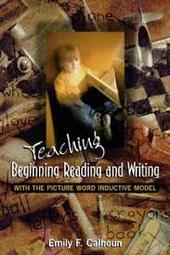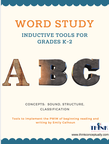 What is Picture Word Inductive Model? The Picture Word Inductive Model (PWIM) created by Emily Calhoun is an excellent model of teaching for developing understandings about language and analyzing how it works inductively. The teacher selects a picture that is relevant to the unit of inquiry from which to develop a visual dictionary (relevant word list). These words are then used for word study and small groups about letter sounds, word structure and classification. Words can be sorted by beginning, middle and ending sounds. Students can also use the words to classify them by nouns, verbs, and adjectives. They can practice ordering a phrase and then co-construct sentences as a station during the Daily 5 CAFE. Finally, a class story can be drafted, edited and published to model the writing process. What are its benefits? Throughout my career as a homeroom teacher with language learners, I have relied heavily on the Picture Word Inductive Model (PWIM) of teaching beginning reading and writing to my grade 1 and 2 students both in Mexico and in Iraq (Calhoun, 1999). As an inductive approach, students inquire into the way language works from concrete, relevant examples rather than beginning with an abstract word list taken out of context. It uses visual scaffolding for comprehensible input (Echeviarría, Vogt & Short, 2017). The more I explored using this approach, the more I appreciated it as a tool for both modeling writing and joint construction in pairs or as a whole class. Students can explore the concepts of sound, structure and classification through inductive word study. They can explore sentence structure using the words from their visual dictionary. They can use their creativity to write a story about the picture. My students enthusiastically engaged in word study with each other. I observed them using the vocabulary we learned through the picture of study and their writing abilities improved as the year progressed since we did so much together. They had multiple opportunities to be exposed to the narrative writing process through joint construction before I asked them to try on their own.  How does it work? Below is an excerpt from the book to help you get started. I have found my own way to implement this model of teaching and explored ways to expand on the premise of PWIM. I have created a variety of tools to use with this approach during centers. These word sort boards are available here: Click here for word sort boards.
Calhoun, E. (1999). Teaching beginning reading and writing with the picture word inductive model. Alexandria, VA: ASCD.
Echevarría, J., Vogt, M. and Short, D. (2017). Making content comprehensible for English language learners: the SIOP method, 5th ed. Boston, MA: Pearson.
0 Comments
|
AuthorAs an international educator, I work with colleagues in my local and global network regularly to implement inquiry through concept-based approaches to learning and teaching. It is a journey of discovery, learning and growing our own understandings about the ways children learn. Categories
All
Archives
March 2020
This website uses marketing and tracking technologies. Opting out of this will opt you out of all cookies, except for those needed to run the website. Note that some products may not work as well without tracking cookies. Opt Out of Cookies |

 RSS Feed
RSS Feed
